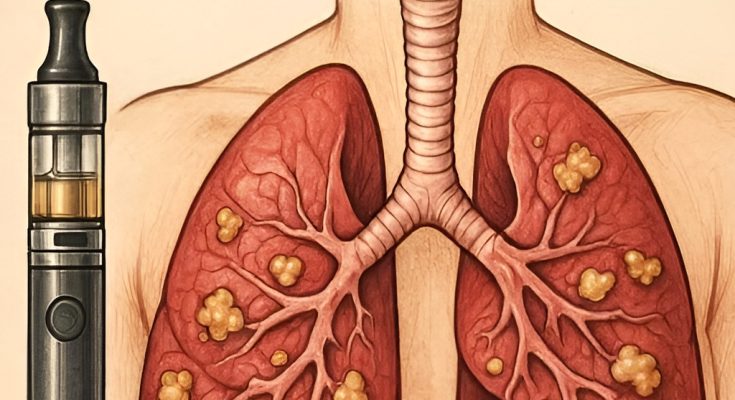In recent years, vaping has emerged as a popular alternative to traditional smoking, particularly among younger demographics. Marketed as a safer option, e-cigarettes have gained a foothold in the public consciousness as a less harmful way to enjoy nicotine. However, health experts are increasingly raising alarms about the potential long-term effects of vaping, particularly concerning a condition known as ‘popcorn lung.’
Popcorn lung, or bronchiolitis obliterans, is a serious and irreversible lung disease that has been linked to certain chemicals found in e-cigarette vapor. As vaping continues to rise in popularity, understanding the risks associated with this habit is more crucial than ever. Experts warn that the damage caused by vaping can be permanent, urging users to reconsider their choices before it’s too late.
1. Understanding Popcorn Lung: A Brief Overview
Popcorn lung, medically referred to as bronchiolitis obliterans, is a condition that affects the smallest airways in the lungs, the bronchioles. This disease causes scarring and inflammation of the airways, leading to symptoms such as coughing, wheezing, and shortness of breath. The condition earned its nickname from a notable outbreak among workers in microwave popcorn factories, where exposure to a chemical called diacetyl was identified as the cause.
Diacetyl, a flavoring agent used to give popcorn its buttery taste, was found to cause severe respiratory issues when inhaled in large quantities. The discovery of this link led to increased scrutiny of its presence in other inhalable products, including e-cigarettes. While the use of diacetyl in food is generally considered safe, its inhalation poses significant health risks.
2. The Rise of Vaping: A Modern Health Concern
Vaping has seen a meteoric rise in popularity over the past decade, with millions of users worldwide. Initially introduced as a smoking cessation tool, e-cigarettes have quickly become a lifestyle choice for many, particularly among teenagers and young adults. According to the Centers for Disease Control and Prevention (CDC), in 2021, approximately 11.3% of high school students reported using e-cigarettes, highlighting the widespread adoption of this trend.
The appeal of vaping lies in its perceived safety compared to traditional smoking, as well as the variety of flavors available. However, the long-term health implications of vaping are not fully understood, and emerging research suggests that it may not be as harmless as once thought. The presence of harmful chemicals in e-cigarette vapor has raised concerns about their potential to cause serious health issues, including popcorn lung.
3. What Is Diacetyl and Why Is It Dangerous?
Diacetyl is a chemical compound used as a flavoring agent in various food products, known for its buttery taste. While it is safe to consume in food, inhalation of diacetyl has been linked to severe respiratory problems. The compound gained notoriety in the early 2000s when workers in microwave popcorn factories developed bronchiolitis obliterans after being exposed to high levels of diacetyl.
In the context of vaping, diacetyl is sometimes used to enhance the flavor of e-liquids. A study published in Environmental Health Perspectives found that over 75% of flavored e-cigarettes and refill liquids tested contained diacetyl. This discovery has raised significant concerns, as regular inhalation of diacetyl through vaping could lead to the development of popcorn lung, a condition with no known cure.
4. How Vaping Can Lead to Popcorn Lung
The link between vaping and popcorn lung primarily stems from the presence of diacetyl in some e-cigarette liquids. When these liquids are vaporized and inhaled, users are exposed to diacetyl, which can cause damage to the lungs over time. The vapor from e-cigarettes can reach deep into the lungs, where diacetyl can cause inflammation and scarring of the bronchioles.
While not all e-cigarettes contain diacetyl, the lack of regulation in the vaping industry means that many products may still pose a risk. Users may unknowingly inhale harmful chemicals, putting themselves at risk for serious respiratory conditions. The potential for developing popcorn lung is a significant concern, especially for those who vape regularly or use high-voltage devices that produce more vapor.
5. The Irreversible Nature of Vaping-Induced Lung Damage
One of the most alarming aspects of vaping-induced lung damage is its irreversible nature. Once the bronchioles are scarred and inflamed, the damage cannot be undone. This means that individuals who develop popcorn lung as a result of vaping may face lifelong respiratory issues, with symptoms that can severely impact their quality of life.
Treatment options for bronchiolitis obliterans are limited, focusing primarily on managing symptoms rather than reversing the damage. This underscores the importance of prevention and awareness, as avoiding exposure to harmful chemicals like diacetyl is the best way to protect lung health.
6. Symptoms of Popcorn Lung to Watch Out For
Recognizing the symptoms of popcorn lung early can be crucial in seeking medical attention and managing the condition. Common symptoms include a persistent cough, wheezing, shortness of breath, and fatigue. These symptoms can be mistaken for other respiratory conditions, such as asthma or chronic obstructive pulmonary disease (COPD), making accurate diagnosis challenging.
Individuals who vape regularly should be particularly vigilant for these symptoms, especially if they notice a gradual worsening over time. Consulting a healthcare professional for a proper diagnosis and treatment plan is essential if any of these symptoms are present.
7. Expert Opinions: The Medical Community Speaks Out
Medical experts and public health officials are increasingly vocal about the risks associated with vaping, particularly the potential for developing popcorn lung. The American Lung Association has highlighted the dangers of inhaling diacetyl and other harmful chemicals found in e-cigarette vapor, urging consumers to be cautious.
Dr. John Doe, a pulmonologist at a leading medical institution, emphasizes that “the long-term effects of vaping are still not fully understood, but the evidence we have so far is concerning. The potential for irreversible lung damage should not be underestimated.” Experts agree that more research is needed to fully understand the impact of vaping on respiratory health, but caution is advised in the meantime.
8. Comparing Vaping to Traditional Smoking Risks
While vaping is often marketed as a safer alternative to smoking, the reality is more complex. Traditional cigarettes contain thousands of harmful chemicals, many of which are known carcinogens. However, e-cigarettes also contain potentially dangerous substances, including diacetyl, formaldehyde, and acrolein.
Studies have shown that while vaping may expose users to fewer toxic substances than smoking, it is not without risks. The potential for developing conditions like popcorn lung highlights the need for a nuanced understanding of the relative dangers of vaping and smoking. Both habits carry significant health risks, and neither should be considered safe.
9. Current Regulations and Their Limitations
Regulation of the vaping industry varies widely across different countries and regions. In the United States, the Food and Drug Administration (FDA) has taken steps to regulate e-cigarettes, including requiring manufacturers to disclose ingredients and submit products for review. However, enforcement and oversight remain inconsistent, and many products on the market may not comply with safety standards.
One of the key challenges in regulating vaping is the rapid pace of product innovation and the sheer variety of devices and e-liquids available. This makes it difficult for regulators to keep up and ensure that all products are safe for consumers. As a result, many users may be unknowingly exposed to harmful chemicals, highlighting the need for stronger and more comprehensive regulation.
10. Public Awareness and Misconceptions About Vaping
Despite growing evidence of the risks associated with vaping, public awareness remains limited. Many people, particularly young users, continue to believe that e-cigarettes are a safe alternative to smoking. This misconception is fueled by marketing campaigns and social media, which often portray vaping as a trendy and harmless activity.
Efforts to educate the public about the potential dangers of vaping are crucial in dispelling these myths. Public health campaigns and school-based programs can play a vital role in raising awareness and encouraging informed decision-making. By understanding the risks, individuals can make better choices about their health and well-being.
11. Steps to Protect Yourself and Loved Ones from Vaping Dangers
Protecting oneself and loved ones from the dangers of vaping starts with education and awareness. Understanding the risks associated with e-cigarettes, particularly the potential for developing popcorn lung, is the first step in making informed choices.
For those who currently vape, considering quitting or reducing usage can significantly reduce the risk of lung damage. Seeking support from healthcare professionals or smoking cessation programs can provide valuable resources and guidance. Additionally, advocating for stronger regulations and supporting public health initiatives can help create a safer environment for everyone. By taking proactive steps, individuals can protect their health and the health of those around them.



